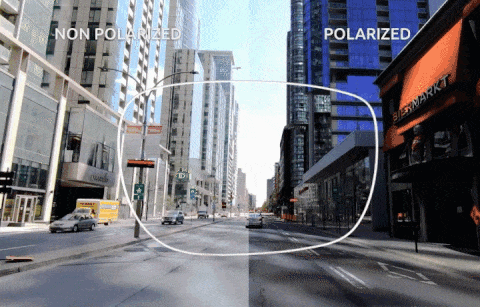Buy One Get One FREE + 25% Off Any Lens Upgrades

- (US) Select $5.95 standard US shipping to have your package delivered in 9-21 days. Or select $20.95 express service for 6-12 days.
- (CA) Select $7.95 standard shipping to have your package delivered in 18-25 days. Or select $19.95 Express Service (Non-Remote Areas Only) for 6-12 days.
- Free US standard shipping on orders over $69.
- We offer 100% satisfaction guaranteed.
- Unsatisfactory glasses can be exchanged or refunded within 60 days of receipt.
- For any glasses imperfection/any possible defect, we can remake totally free or offer a full refund.
- Real people help on fit, style, prescription.
- Firmoo 24/7 one-on-one real customer service is ready to help from finding best-match to after-sale warranty.
- NEW WAY TO ORDER: our assistant helps you create a shopping cart based on your needs.
Popular among people who spend a lot of time outdoors, on the road and particularly near water.
Eliminate 99.9% of glare
Enhances color and contrast
Promote eye health


- (US) Select $5.95 standard US shipping to have your package delivered in 9-21 days. Or select $20.95 express service for 6-12 days.
- (CA) Select $7.95 standard shipping to have your package delivered in 18-25 days. Or select $19.95 Express Service (Non-Remote Areas Only) for 6-12 days.
- Free US standard shipping on orders over $69.
- We offer 100% satisfaction guaranteed.
- Unsatisfactory glasses can be exchanged or refunded within 60 days of receipt.
- For any glasses imperfection/any possible defect, we can remake totally free or offer a full refund.
- Real people help on fit, style, prescription.
- Firmoo 24/7 one-on-one real customer service is ready to help from finding best-match to after-sale warranty.
- NEW WAY TO ORDER: our assistant helps you create a shopping cart based on your needs.
Popular among people who spend a lot of time outdoors, on the road and particularly near water.
Eliminate 99.9% of glare
Enhances color and contrast
Promote eye health


What are polarized sunglasses? Polarized sunglasses are designed to reduce glare, especially from the surfaces like water, snow, and glass. It is commonly used in sports such as driving and fishing by helping the wearers in these activities to see more clearly, allowing for the avoidance of potential hazards. Since light is made up for waves traveling in different directions. Vertical light is useful to the human eye. It helps us to see. However horizontal light simply creates glare. Glare is concentrated light reflecting off a horizontal shiny surface, such as a car windscreen, sand, water, and snow or asphalt roads. It reduces visibility and can make it uncomfortable, painful and even dangerous to carry on driving, cycling, skiing or just sunbathing.
As we all know that we see by virtue of the light that enters our eyes in sunny days. Without good sunglasses, brightness and glare result in a loss of visual performance, which is produced when an object or light source in the field-of-vision is brighter than the amount of light to which the eyes are adapted. Most sunglasses will provide some absorption to dampen brightness, but only polarized sunglasses can effectively eliminate blinding glare. However, polarized sunglasses are not recommended to pilots. Polarized lenses eliminate reflected glare from a flat surface. However, looking through a laminated aircraft windscreen, while wearing polarized lenses can result in a reduced retinal image. Also, some windscreen of aircraft is already polarized, hence polarized sunglasses result in double polarization. Moreover, some 3-D movies also use polarizing lenses. Usually, one lens is horizontally polarized and the other one is vertically polarized so that each eye sees a slightly different version of the movie screen. The eyes attempt to reconcile the two images for the brain, and the result is the illusion of a three-dimensional image. Experimenters with several spare pairs of 3-D glasses lying around can play with the effects of polarization for themselves.
Since we have already know the usage of polarized sunglasses, how do I know if my sunglasses are polarized? If you have the same doubt, you can just look through the glasses at the reflection of any object on a window panel. Then, turn the sunglasses around as if they were the hands of a clock facing you. If the intensity of the reflection doesn't change with respect to what you see through the window, they are not polarized. Another way is to hold them at 90° to another pair labeled as polarized and if the lenses go dark where the lenses overlap, then your sunglasses are polarized too. If there's no change, your lenses aren't polarized. Moreover, not all polarization is equal. Because not all polarized sunglasses block glare as well as they should. A polarizing filter is no guarantee of an effective glare-blocking lens. It depends on the quality of the filter and how the lens has been produced. Cheap polarized sunglasses may only cut out 10% of reflected light, but many people don't realize there is a difference in filter quality in better-made glasses. For example, Julbo's Polycarbonate Polarized lenses cut out around 60-70% of reflected light, and the NXT Cameleon, Octopus and Polar HD lenses cut out 99% of reflected light.

Copyright © 2025 Firmoo Online Optical Store.All Rights Reserved









